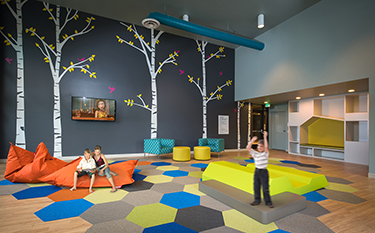|
Subscribe / Renew |
|
|
Contact Us |
|
| ► Subscribe to our Free Weekly Newsletter | |
| home | Welcome, sign in or click here to subscribe. | login |
Real Estate
| |
 |
June 22, 2017
Renters seek buildings that reflect their lifestyles
Ankrom Moisan

Hayes
|
Seattle’s discerning apartment dwellers want more than upscale amenities — they want an experience.
Today’s multifamily residents view their buildings as an extension of their own identities. What does the building they live in say about them? It says a lot.
Supply and demand
According to Dupree + Scott, greater Seattle is slated to receive 16,000 new apartment homes in 2017, with another 18,000 to be completed through 2018. Those numbers sound high until you consider that the U.S. Census Bureau estimates our region is growing by nearly 1,100 people per week.
The issue developers and property managers need to address now is differentiation.
Today’s sophisticated renters want amenity spaces that represent and enhance their ideal lifestyles. The building they choose to live in is an extension of their personal brand, a filter through which others see them. Discerning urban renters want their residential building — not just their personal apartment — to reflect their lifestyle, or the lifestyle they aspire to have. Furthermore, they want authenticity: contextual materials, architecture that reflects a sense of place, and interior spaces representative of local values and culture.
That is where thoughtful, experiential interior design and tangible building identities make all the difference.
Designing a lifestyle
As urban apartment units are shrinking in size, successful amenities and common spaces are extensions of residents’ living spaces. The amenity race is real, and with Seattle’s progressive requirement that 5 percent of project square footage (or equal to the site area, whichever is larger) be set aside for building amenities, it means that all new multifamily housing in the city and surrounding areas will offer an array of perks.
Run-of-the-mill amenities might bring renters through the door today, but they won’t necessarily retain tenants or build resident loyalty for tomorrow.
So how do designers ensure that residential amenities speak to renters across generations, genders and cultures? We tell a story. Today’s renters typically have a strong opinion about a building before they’ve walked into the leasing office.
A residential community’s online presence is a first impression: a website, Facebook posts, and a carefully curated Instagram feed are not just promoting apartments — they’re promoting a brand. This is the first place that a building’s identity can begin to set your property apart in this market.
It is critical that those first impressions match the experiences and design that the building offers to the potential resident.
Ankrom Moisan’s most successful multifamily projects are those in which architecture, interior design and branding are working together in the design process as early as possible — those are the developments with the best stories to tell. These projects best capture the imaginations and emotions of the end users, and keep residents feeling immersed and connected.
A well-designed and branded apartment development will give residents an engaging experience and, just like a good story, they will want to share it with others.
People see through gimmicks, and that includes contrived design. If amenity spaces are too trendy or overly styled, they will not resonate with residents. If renters don’t feel an authentic connection with the amenities, then they will never serve their purpose of enhancing tenants’ residential experiences.
The higher rent that tenants are paying for amenities isn’t worth it when they don’t use them, and when the lease ends the tenants may look for something that better suits their personalities and lifestyles — and then your investment is losing money.
To be successful, amenity spaces must be thoughtfully executed and purposefully enhance the building’s appeal. Matching what the building next door offers is not enough to stand out and be resilient in the long term.
Your design team must work with you to identify what purpose each space fulfills, and find an authentic use for the space that will resonate with tenants, and promote the values of the brand and the experience it’s selling. The same amenity square footage can be programmed into countless spaces, but will they matter to residents? If the answer is no, it’s time to go back to the drawing board.
Diving deep into values
Programming amenities that support and highlight the lifestyle of residents requires a deep dive into who they are. The first step in creating a narrative for their residential experience is working closely with our clients to identify the target residents, and then truly understanding their values. For the health-conscious renter, a small, dark fitness room won’t work; whereas, the couple that is downsizing will seek out spaces that allow them to continue entertaining friends and family.
Every design and branding decision we make is tested against this mindset from the beginning — if it does not align with the resident story, we rework it.
The interiors of a building influence how people live and experience their lives. It is in these spaces that the success of a development is made or lost. Taking the time to understand the people for whom you are designing, and meeting those needs through design in a cohesive and attentive way, is what makes for truly special communities.
Heather Hayes, LEED AP ID+C, is a managing principal at Ankrom Moisan and leads the firm’s Seattle Interior Design studio. A graduate of Willamette University, she had a career in public affairs before following her passion and receiving a degree in interior design from Bellevue College.
Other Stories:
- New towers create a construction tango in downtown Seattle
- Affordable housing gets a boost from impact investors
- Bremerton’s triple treat: affordability, nature, life balance
- When it comes to apartments, one size doesn’t fit all
- Unused building? Consider housing homeless families there
- Westbank tees up 3 big projects in Seattle
- Ready for a revolution in urban transportation?
- Buildings soar skyward as modular frame systems evolve
- Don’t question the value of green design — bank on it



